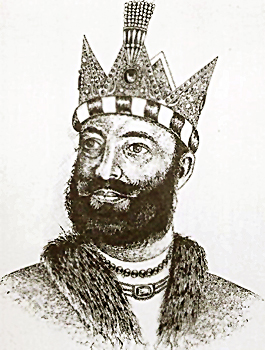 Yamini dynasty is of Turkish origin and included large extent of Persia and Northern India. Mahmud of Ghazni was the crowned ruler of this empire though it was founded by Sebuktigin. Sebuktigin`s son, Mahmud, expanded the empire that stretched from the Oxus River to the Indus Valley and the Indian Ocean; and in the west it reached Rayy and Hamadan. After Mahmud, Masud took over the kingdom. Under Masud`s reign western territories were lost to the Seljuqs in the Battle of Dandanaqan. As far as their rule in India was concerned, the rulers, from time to time, had plundered Hindusthan. However, they always received resistance from the Rajput rulers belonging to different clans.
Yamini dynasty is of Turkish origin and included large extent of Persia and Northern India. Mahmud of Ghazni was the crowned ruler of this empire though it was founded by Sebuktigin. Sebuktigin`s son, Mahmud, expanded the empire that stretched from the Oxus River to the Indus Valley and the Indian Ocean; and in the west it reached Rayy and Hamadan. After Mahmud, Masud took over the kingdom. Under Masud`s reign western territories were lost to the Seljuqs in the Battle of Dandanaqan. As far as their rule in India was concerned, the rulers, from time to time, had plundered Hindusthan. However, they always received resistance from the Rajput rulers belonging to different clans.
Subaktagin, a Turkish slave, ruled nearly all the present territories of Afghanistan and of the Punjab. In 997, Mahmud, the son of Subaktagin, succeeded his father and with him Ghazni and the Yamini dynasty have become perpetually associated. It was after Mahmud that the dynasty was named. He established his supremacy over North India and set up tributary states. He established his authority from the borders of Kurdistan to Samarkand and from the Caspian Sea to the Yamuna River.
The wealth brought back to Ghazni from the Indian expeditions was massive. Mahmud died in 1030. Mahmud`s son Masud was unable to keep the empire intact. He had to face a defeat at the Battle of Dandanaqan and lost all the Ghaznavid lands in Iran and Central Asia to the Seljuks. Masud was succeeded by his son Ibrahim who re-established a truncated empire by arriving at a peace agreement with the Seljuks and also by restoring cultural and political linkages. Under Ibrahim and his successors the kingdom experienced a sustained tranquility. When Masud III died signs of weakness dawned in the empire. However throughout their rule, the rulers of this dynasty were constantly engaged in clashes with the Rajput clans in India.
Under Ibrahim and his successors the kingdom experienced a sustained tranquility. When Masud III died signs of weakness dawned in the empire. However throughout their rule, the rulers of this dynasty were constantly engaged in clashes with the Rajput clans in India.
Ibrahim, for instance, led many expeditions against Indian chiefs and conquered Tabarhindah (modern Sirhind), Dhangan, Jalandhar and other regions. In 1075 AD he appointed his son Mahmud as the governor of the Punjab. Mahmud led an expedition into India, and conquered Agra by defeating its chief Jaipal. Kannauj, which was ruled by the Rashtrakuta family, passed into his hands. He next invaded Ujjain, but was repulsed by the Paramara ruler, Lakshmadeva. Mahmud also attacked the Fort of Kalanjara, which was then ruled by the Chandela ruler, Kirtti Varman. Mahmud`s expeditions against the Indian chiefs were similar to plundering raids.
Later it was Masud or Alauddaulah Masud III who succeeded Ibrahim in 1099 AD. In a spree to conquer the neighbouring regions, Hajib Tughatigin, an officer under the Sultan, attacked Kannauj and imprisoned Gahadavala Madanachandra. Madanachandra`s son Govindachandra defeated the Muslims, and secured the release of his father.
Sultan Bahram Shah was the last ruler of Ghazni, the first and main Ghaznavid capital. Ala-ud-din Hussain, a Ghori King, conquered the city of Ghazni. Ghaznavids reinstated Ghazni by the intervention of the Seljuks. Ghaznavid power in northern India continued until the conquest of Lahore from Khusrau Malik.
The Ghaznavid Empire controlled much of present-day Iran, Afghanistan, Pakistan, and northwest India. They launched Islam into Hindu dominated India. The Yamini dynasty also benefited from their position as a mediator along the trade routes between China and the Mediterranean. They were unable to hold power for long and the Seljuks had taken over their Persian domains and a century later they took over their remaining lands.



















